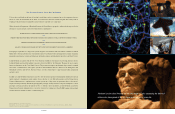Lockheed Martin 2002 Annual Report Download - page 20
Download and view the complete annual report
Please find page 20 of the 2002 Lockheed Martin annual report below. You can navigate through the pages in the report by either clicking on the pages listed below, or by using the keyword search tool below to find specific information within the annual report.
TWENTY-SEVEN
results of those audits and investigations, the Government
could make claims against us. Under Government procure-
ment regulations and practices, an indictment of a government
contractor could result in that contractor being fined and/or
suspended from being able to bid on, or be awarded, new gov-
ernment contracts for a period of time. A conviction could
result in debarment for a specific period of time. Similar gov-
ernment oversight exists in most other countries where we
conduct business. Although we cannot predict the outcome of
these types of investigations and inquiries with certainty,
based on current facts, we do not believe that any of the
claims, audits or investigations pending against us are likely to
have a material adverse effect on our business or our results of
operations, cash flows or financial position.
Changes in government procurement policies and practices
over the past several years, such as increases in the progress
payment rate and the use of performance-based payments, have
had a positive effect on our financial position and cash flows.
But we are still exposed to risks associated with U.S.
Government contracting, including technological uncertainties
and obsolescence, and having to depend on Congressional
appropriation and allotment of funds each year. Many of our
programs involve the development and application of state-of-
the-art technologies aimed at achieving challenging goals. As
a result, setbacks, delays, cost overruns and failures can occur.
In addition to our defense businesses, we also provide
products and services to civil government customers, as well
as commercial customers. Relative to civil government cus-
tomers, in 2002, a joint venture in which we are participating
was awarded the contract for Deepwater, a modernization pro-
gram for the Coast Guard’s fleet and systems. Our role will be
to provide systems integration and engineering; C4ISR; air
assets; and integrated logistics support. In addition, we pro-
vide products and services to agencies such as the U.S. Postal
Service, the Federal Aviation Administration, NASA and the
Transportation Security Administration. Although our lines of
business in civil government and commercial markets are not
dependent on defense budgets, they share many of the same
risks as our defense businesses, as well as other risks unique to
their particular marketplaces. These risks may include devel-
opment of competing products, technological feasibility and
product obsolescence.
With respect to our work with NASA, we provide products
and services for the Space Shuttle program mainly through our
Space Systems and Technology Services business segments. In
2002, work for NASA accounted for approximately 6% of our
consolidated net sales, of which approximately one-half was
related to the Space Shuttle program. We also have a 50%
equity interest in United Space Alliance, LLC, which provides
ground processing and other operational services to the Space
Shuttle program. We are working with the Columbia Accident
Investigation Board and NASA in the investigation of the
February 2003 accident involving the Space Shuttle Columbia.
This tragic event did not impact our results of operations for
2002, and it is too early to determine whether the accident will
affect our business operations for 2003 and beyond.
We have entered into various joint venture, teaming and
other business arrangements to help support our portfolio of
products and services in commercial space as well as other
lines of business. For additional information about these ven-
tures, see the discussion in the next section concerning our
“Commercial Space Business,” the discussion on page 34 cap-
tioned “Write-Off and Restructuring of Investment in
Astrolink,” and the discussion on page 45 relating to Space
Imaging under the caption “Capital Structure and Resources.”
These arrangements generally include a formal plan for fund-
ing the business which usually requires commitments from the
partners, and may require the business to get financing from
other sources as well. To the extent the business is unable to
get financing from other sources, the business partners, our-
selves included, would be required to look at alternatives for
funding the business. Some of these business arrangements
include foreign partners. The conduct of international business
introduces other risks into our operations, including changing
economic conditions, fluctuations in relative currency values,
regulation by foreign countries and the potential for unantici-
pated cost increases resulting from the possible deterioration
of political relations.
The nature of our international business also makes
us subject to the export control regulations of the U.S.
Department of State and the Department of Commerce. If
these regulations are violated, it can result in monetary penal-
ties and denial of export privileges. We are currently unaware
Lockheed Martin Corporation
























